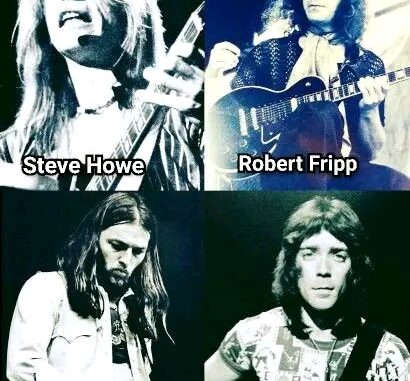
**UNSUNG: Great Progressive Rock Guitarists, Part 2**
In the vast, sprawling universe of progressive rock, certain names shine brightly—Yes, Steve Howe; Genesis’s Steve Hackett; King Crimson’s Robert Fripp. They are the titans whose innovative riffs and visionary playing have shaped the genre’s trajectory. Yet, lurking beneath the spotlight are a handful of guitarists whose contributions, while equally profound, remain largely unrecognized outside dedicated circles. Today, we shine a light on four such maestros—Andrew Latimer, Gary Green, Steve Hillage, and Martin Barre—artists whose unique voices and pioneering spirits have indelibly marked prog’s rich tapestry.
**Andrew Latimer: The Soulful Architect of Camel**
Few guitarists embody the emotive and melodic sensibility of Andrew Latimer. As the founding member of Camel, Latimer’s playing is characterized by lyrical lines, lush harmonies, and a keen sense of storytelling through sound. His tone—warm, expressive, and layered—serves as the emotional core of Camel’s progressive journeys.
While Camel never achieved the household name status of some of their contemporaries, their intricate compositions and Latimer’s evocative guitar work have garnered a devoted following. Albums like *The Snow Goose* and *Moonmadness* showcase his ability to blend jazz-influenced improvisation with classical elegance, creating soundscapes that are both contemplative and expansive.
In interviews, Latimer often emphasizes the importance of mood and emotion over technical flash. His solos are not about speed but about conveying feeling—an underrated trait in an age obsessed with virtuosity. His use of effects and layered textures adds depth, making each song a carefully crafted narrative.
**Gary Green: The Virtuosic Trailblazer of Gentle Giant**
Many listeners overlook Gentle Giant’s guitarist, Gary Green, despite his reputation as one of the most inventive and technically skilled players in progressive rock. Green’s guitar work is characterized by complex chord voicings, unpredictable timing, and a mastery of blending classical, jazz, and rock idioms.
Green’s approach was often experimental—pushing the boundaries of conventional guitar playing. His use of alternate tunings, unusual scales, and rhythmic intricacies lent Gentle Giant’s music its distinctive, cerebral quality. Albums like *Octopus* and *Free Hand* reveal a guitarist unafraid to challenge the listener, weaving intricate melodies into dense, polyphonic arrangements.
What sets Green apart is his capacity to serve the song’s narrative rather than showcase his own virtuosity. His playing adds layers of nuance—sometimes subtle, sometimes startling—that reward attentive listening. Yet, despite the technical mastery, Green remains an “unsung” hero, overshadowed by more prominent names, though his influence is palpable among prog guitar aficionados.
**Steve Hillage: The Psychedelic Innovator**
A name that often escapes the mainstream gaze but whose guitar work is essential to the psychedelic and progressive scenes of the 1970s, Steve Hillage’s style is characterized by cosmic textures, inventive effects, and a boundless sense of exploration.
Hillage’s tenure with Gong and his solo projects exemplify a guitarist constantly pushing sonic boundaries. His use of delay, reverb, and phasing creates expansive soundscapes that evoke otherworldly realms. Albums like *L* and *Green* showcase his ability to combine melodic invention with experimental sound design.
Hillage’s playful yet profound approach to guitar—melding Eastern scales, jazz improvisation, and ambient effects—makes his soundscape both immersive and inspiring. His work influenced countless musicians in the psychedelic and prog scenes, yet he remains underappreciated outside niche circles.
**Martin Barre: The Steady Hand of Jethro Tull**
While Jethro Tull’s Ian Anderson often garners the spotlight, Martin Barre’s guitar work forms the backbone of the band’s distinctive sound. Barre’s playing is marked by a blend of folk-inspired melodies, bluesy phrasing, and the use of the flute-like tone he crafts with his Gibson Les Paul.
Albums like *Aqualung* and *Thick as a Brick* feature Barre’s compelling solos—melodic, expressive, and rooted in tradition yet inventive enough to complement the band’s complex arrangements. His rhythm work provides a steady pulse that anchors Tull’s intricate compositions.
Though Barre’s style might seem more straightforward compared to the experimental giants of prog, his mastery lies in his ability to serve the song. His understated approach ensures that each guitar part enhances the narrative without overshadowing the overall composition. Despite his critical role, Barre remains somewhat unsung compared to the frontmen but is revered by dedicated fans.
—
**The Unrecognized Pillars of Prog**
These four guitarists—Latimer, Green, Hillage, and Barre—embody the spirit of prog’s exploratory ethos. Their work demonstrates that innovation doesn’t always come with widespread fame. Instead, it resides in the subtle nuances, emotional depth, and daring experimentation that define their playing.
In an era where the spotlight often favors flash and speed, these musicians remind us that true artistry lies in storytelling through sound, in pushing boundaries while serving the song. Their contributions may be “unsung” by mainstream standards, but for those who listen closely, their legacy is undeniable and inspiring.
As prog continues to evolve, let us celebrate these unsung heroes—artists whose quiet brilliance has shaped the genre’s soul. Because in the end, it’s not just the fame but the passion and innovation that make a guitarist truly legendary.
Leave a Reply